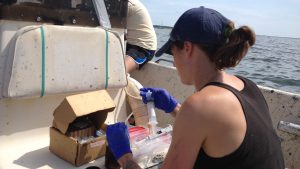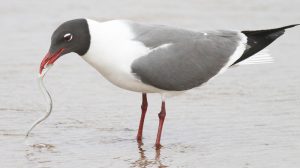Search results for: ❤️ Dating für mich: www.Dating4Me.site ❤️ Costaki Economopoulos Dating
WHOI-R-98-003 Gonzalez-Gil, S. Detection and
WHOI-R-98-003 Gonzalez-Gil, S. Detection and
Read MoreShellfish
Shellfish Research » Identification of the cause of hemic neoplasia in Mercenaria mercenaria and development of management methods NRAC-USDA Fall 2017 – Fall 2019 » Market Development to Diversify Shellfish Aquaculture Products in Massachusetts NOAA SG Aquaculture Initiative: Addressing Impediments to Aqua. Opportunities Sept. 2017 – Sept. 2019 » Piloting surf clam aquaculture techniques to…
Read MoreUnderstanding the Waquoit Bay Ecosystem
A Q&A with Sarah Foster Sarah Foster is a Boston University graduate student doing her dissertation research in Waquoit Bay (Cape Cod, Massachusetts). A biogeochemist, Sarah investigates the impact hypoxia, or low oxygen, in the water has on crucial functions within Waquoit Bay’s ecosystem. She recently published research she and her co-author, Wally Fulweiler conducted in…
Read MoreAquaculturists
Aquaculturists Our region is home more than 300 shellfish farming operations on over 1,000 acres. Woods Hole Sea Grant extension agents meet regularly with aquaculturists and provide them with technical assistance based on research and our knowledge of local habitats and conditions. WHSG also offers professional development opportunities to help shellfish farmers improve their operations.…
Read MoreTechnology Enables Better HAB Monitoring and Mapping
Technology Enables Better HAB Monitoring and Mapping The project’s sampling plan for the Nauset area of Cape Cod. Sept. 2018 — Nauset Marsh in Eastham, Mass. on Cape Cod serves as a “natural laboratory” for researchers working to better understand harmful algal blooms (HABs) or red tide. HABs in Nauset are caused by the phytoplankton…
Read MoreUpdrift Migration of Tidal Inlets
Updrift Migration of Tidal Inlets Aubrey, D.G. and P.E. Speer Journal of Geology, Vol. 92, pp. 531-545, 1984 WHOI-R-84-009 Migration of tidal inlets and the associated changes in adjacent barrier beaches have profound implications on both the geological evolution of inlet/estuary systems and the short-term stability of these features. Past studies have documented many instances…
Read MoreOctober 2020 Newsletter
Coastal Impacts Woods Hole Sea Grant Newsletter OCTOBER 2020 CONTENTS Letter from the Director Woods Hole Funded Project Impacts Future of Iconic Industry in Southeastern Massachusetts WHSG Hosts Virtual “Teacher-in-Residence” Staff Assists on Crucial Model Floodplain Bylaw Update Getting To Know – Knauss Fellow Sean McNally Needs Assessment Survey Helps Program with Strategic Planning…
Read MoreThe Little Fish with a Big Impact
In the Gulf of Maine, there’s a little eel-like fish not much bigger than a large pencil, that buries itself in the sand in the summer and swims up and down in the water column in the spring and fall. It’s called a sand lance and it’s incredibly important to the ecosystem of the Gulf of Maine. If you like whale watching, this little fish is the biggest reason you might or might not see a whale:
Read MoreAugust 2020 Coastal Impacts Newsletter
Coastal Impacts Woods Hole Sea Grant Newsletter AUGUST 2020 CONTENTS WHSG Supports Seven Diversity, Equity and Inclusion Projects 12 Weeks, Thousands of Kids: How NOAA Live! Connected Students to Science at Home Woods Hole Sea Grant Sponsors Three for Knauss Fellowship Is There a Market for Shucked Oysters? Eat an Oyster, Support a Local…
Read MoreSurf Clams
Surf Clams In the marketplace, one-year-old surf clams are known as “New England Butter Clams” – a relatively new product on the market. Farming New England Butter Clams means they can be harvested at a size in which they are tender, buttery and sweet – as well as easy and versatile to prepare. This results…
Read More

